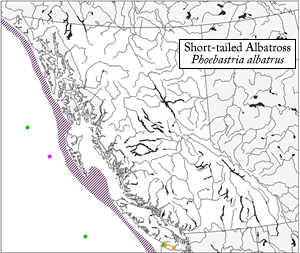Adult
This plumage is not acquired until ~12-20 years of age. The back, scapulars, rump, and uppertail coverts are entirely white. The outer half of the upperwings, including the primaries, primary coverts, outer secondaries, and outer secondary coverts is blackish, contrasting sharply with the largely whitish inner half of the upperwings (including most of the inner secondary coverts and inner secondaries); there is also a blackish area along the leading edge of the wing, a narrow blackish trailing edge of the wing, and an isolated blackish area on the inner secondaries, as well as a whitish flash on the upperside of the outer primaries due to the whitish feather shafts. The tail is black with a white base. The underparts are wholly white, sometimes with a faint yellowish wash on the breast. The underwings are almost entirely white except for a narrow blackish leading edge, trailing edges, and tips of the primaries. The head is white with a heavy golden-yellow wash on the crown, nape, hindneck, and sides of the neck; the remainder of the head and neck are also sometimes faintly washed with golden-yellow. The iris is dark, the heavy, long, tick bill is bright pink with a pale blue tip, and the legs and feet are pale blue-grey to pinkish-grey.
Sub-adult
Prior to attaining full adult plumage, individuals progress through a prolonged subadult plumage. This plumage is more or less similar to the plumage of the adult but retains some brown on the back of the head and hindneck and has somewhat more extensive blackish and dark brown on the upperside of the wings and, in younger birds, a variable amount of dark mottling on the lower back. The brown wash on the back of the head is the last characteristic of immature plumage that is lost prior to attaining full adult plumage.
Immature
This species goes through a complex series of immature plumages throughout the first 10-20 years of life, gradually acquiring a primarily white adult plumage. Young immatures are similar to the entirely dark brown juveniles but gradually acquire pale feathering on the face and underparts, although these pale areas are often separated by persistent brown feathering across the throat in younger immatures. These young immatures also acquire isolated white patches on the middle secondary coverts on the upperside of the wings. As they mature, the face and underparts continue to whiten, later followed by the underwings, back, scapulars, and rump; a second white patch then appears on the innermost secondary coverts on the upperside of the wings. Individuals at this stage often appear mottled with brown and white on the upperparts, although they retain an extensive area of dark brown on the back of the head and hindneck. The tip of the bill also becomes pale bluish at this stage. Older immatures begin to approach the plumage pattern of the adult in that they are largely white on the underparts, upperparts, head, and neck, but retain a brownish area on the back of the head and hindneck, variable brown mottling on the upperparts, more extensive brown mottling on the underwings, and more extensive blackish or dark brown on the inner half of the upperwings (resulting in an isolated white patch on the middle part of the wing).
Juvenile
This plumage is held throughout the first year. Juvenal birds are entirely dark brown, including the body, wings, tail, and head, although there is often a small amount of pale or whitish feathering on below the eye or, in slightly older birds, around the base of the bill. The feather shafts of the outer primaries are whitish, creating a pale flash in the outer part of the wing. The large bill is entirely bright pink, and the legs and feet are pale blue-grey.
Measurements
Total Length: 84-94 cm
Wingspan: 213-230 cm
Mass: 3,700-6,600 g
Source: Harrison (1983); U.S. Fish and Wildlife Sevice (2008)

